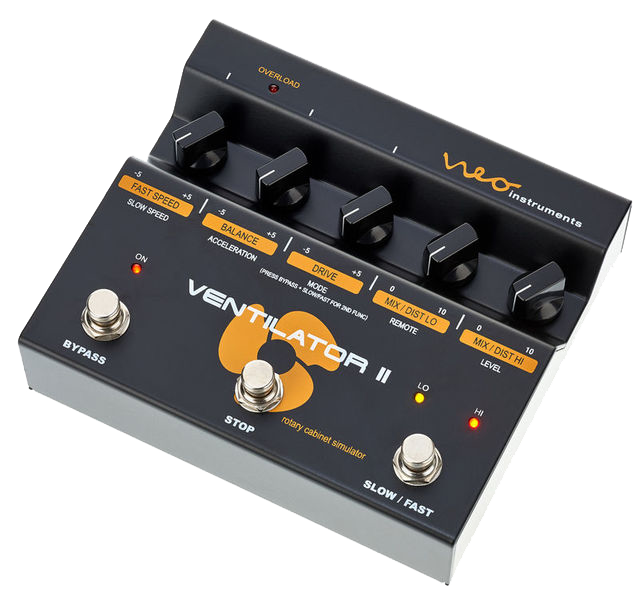Guido Kirsch, the man behind Neo Instruments, is no stranger to the scene. The founder and head honcho of access music, he teamed up with Christoph Kemper to develop VIRUS, a virtual analog synthesizer unveiled at the 1997 Musikmesse.
In 2007, after leaving access music, Guido Kirsch needed a new launch platform for his ideas so he founded Neo Instruments. Uncompromising instruments for discerning musicians – that’s the philosophy behind Neo Instruments.
MiniVent
Don't let the size and seemingly simple appearance fool you. The MiniVent features the same, meticulously modeled authentic 122 rotary sound as its bigger brother, but with fewer immediate controls, for portability and a snug fit in any guitarist's board. The MiniVent comes in two versions, one for guitars (Hi-Z) and one for organs. The guitar version can switch off the amp model, while the organ version lets you choose betweeen 5 drive and mic distance settings via a special programming mode. Switch speeds, and start/stop via the 2 dedicated switches. Pushing them simultaneously will bypass the unit.
Ventilator II
VENTILATOR II simulates a 122 model rotary cabinet, mic’ed up with a stereo pair on top for the treble rotor and a single mono mic below for the drum holding the woofer. The Distance knob lets you move the virtual microphones closer in for lots of amplitude modulation with an intense stereo effect and further out to conjure more diffuse sounds with gentle modulation. The two Speed knobs – one for the drum and one for the treble rotor - adjusts the two rotors’ velocities, and the Acceleration knob determines acceleration and deceleration time. As on the original, the bass and treble rotors run out of sync at slightly different speeds. Acceleration and deceleration times also differ, with the bass rotor taking much longer to speed up and slow down. The Balance knob adjusts the relative levels of the two rotary speakers.
The Drive section is another awesome sound-sculpting tool in VENTILATOR II’s kit. Don’t expect the buzz-saw rasp of a transistor-powered fuzz because it delivers all the warmth of bona fide tube-flavored overdrive. The Drive knob dials in everything from a touch of grit to a real rock roar, all of which can be controlled extremely dynamically via an organ’s volume pedal. VENTILATOR II comes with stereo in- and outputs. The Lo / Hi switch matches input gain to the signal source. You can insert VENTILATOR between your instrument and an amp or mixing console as well as into an FX loop. The new version also features an expression pedal input whion can control either rotor speed or mix/distance.
VENTILATOR II is a stompbox by design, but you can set it on an organ or keyboard for easier access to the knobs. Switching speeds is simple enough, either directly via the Slow/Fast stomp-switch on the device or remotely via a half-moon or external footswitch. It also now features a Stop switch. One LED each indicates the respective rotor’s current speed. An elaborate filter circuit emulates the frequency response of a tube-driven cabinet with exacting precision. When using a guitar amp, simply set the switch to GIT to defeat the speaker simulation and obtain practically linear frequency response. VENTILATOR II comes with a true bypass designed especially for use with guitars. This relay circuit patches the input signal through to the two outputs with no loss of tone or level.



